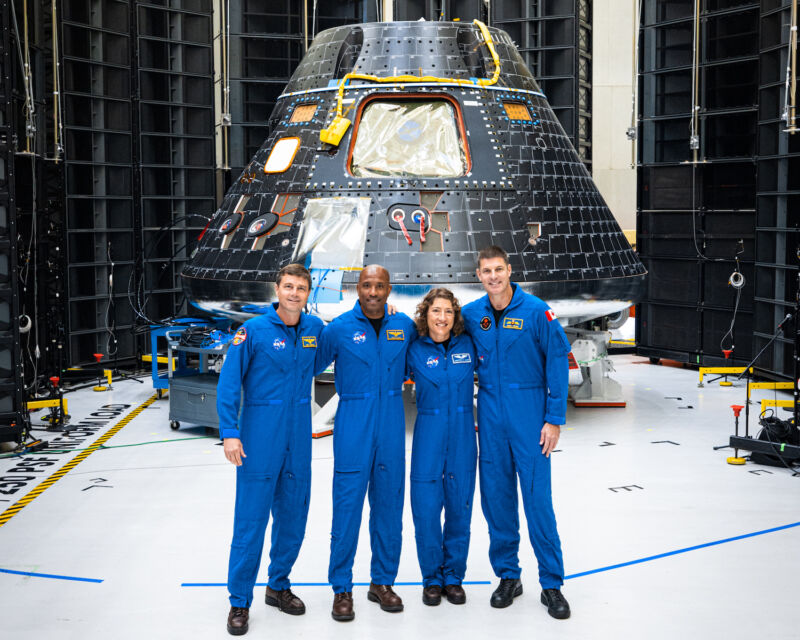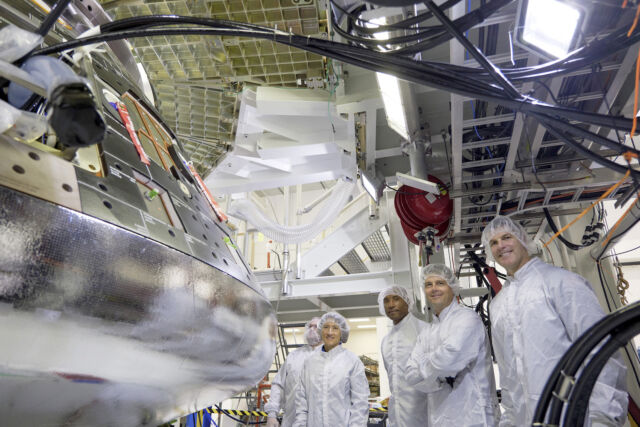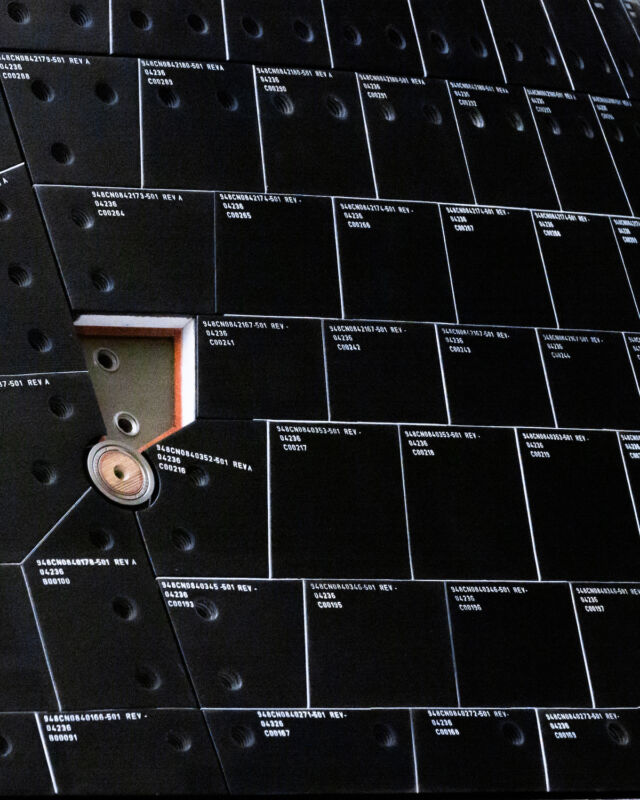
The three Americans and one Canadian slated to fly on NASA's Artemis II circumlunar mission had a "pinch me" moment Monday when they got their first chance visit the Orion spacecraft that will carry them around the Moon and back to Earth.
The astronauts had an opportunity to peer through the hatch of the Orion crew capsule for the Artemis II mission, now largely complete and going through some final tests before it is connected to its power and propulsion module at NASA's Kennedy Space Center in Florida.
"We all said when we walked up to it the first time, that it gave us chills, and it really does," said Christina Koch, a mission specialist on the Artemis II mission. "So it's a new way that I feel bonded with this crew and also with the team."
This week's crew visit to Kennedy Space Center is far from their last as the astronauts ready for their mission—the first flight by humans to the vicinity of the Moon since the last Apollo mission in 1972. On future trips to the Florida spaceport, Koch and her crewmates will climb inside the Orion crew module multiple times for testing and checkouts. Some time next year, they'll put on their orange pressure suits and strap into their seats for a full-up end-to-end test of the spacecraft's software, cockpit displays, and life support system.
"It was great to look inside," said Reid Wiseman, the Artemis II commander. "The fit and finish is gorgeous. It's neat to see the actual hardware all coming together. The things that we've learned about so far in training, to see it for real in the spacecraft, it just gave you a good sense of how far along this thing is. The hardware is is nearly ready."
Far along, but more work to do
Right now, the 16.5-foot-diameter (5-meter) Orion crew module—nearly 4 feet wider than the Apollo command module from the first era of lunar exploration—is situated at one end of the long hall of the cavernous Neil Armstrong Operations & Checkout Building at Kennedy. A stack of powerful speakers surround the Orion capsule on three sides.
The upper part of the gumdrop-shaped spacecraft is covered in black silica tiles similar in appearance to the thermal protection tiles that flew on NASA's space shuttle. On the bottom, the spacecraft's main heat shield is attached, with a reflective silver coating applied over an ablative material that will take the brunt of the nearly 5,000-degree Fahrenheit (2,800-degree Celsius) heat generated at the end of the mission when the capsule plunges back through Earth's atmosphere at a speed equivalent to 32 times the speed of sound.
Later this week, the speakers will start blasting the Orion crew module with sounds that mimic the acoustic energy from a rocket launch. The direct field acoustic test is designed to ensure the spacecraft can weather the intense sound from the engines and boosters of NASA's Space Launch System rocket, which will send the Artemis II crew into space.
It's one of the last big tests before technicians raise the Orion crew module, built by Lockheed Martin, on top of the Orion service module, made by Airbus through an agreement between NASA and the European Space Agency. The finishing touches on the Orion crew module have taken longer than expected, and the connection of the two Orion modules is now expected in mid-September, two-to-three months later than NASA forecast earlier this year.
Preparing the crew module element of the Artemis II mission—where the astronauts will live during their roughly 10-day loop flight around the far side of the Moon— is now driving the launch date, according to Jim Free, who leads the NASA division responsible for developing hardware for the Artemis lunar program.
The preparations are running a "number of weeks" behind the schedule NASA needs to maintain the target Artemis II launch date in late November 2024, Free said. Not surprisingly, that means a delay into 2025 is likely.
"The crew module is the critical path right now," Free said in a press conference Tuesday at Kennedy. "We have to get the crew module assembled and tested, and then mated to the service module, and turn it over to the ground systems folks here for processing."

NASA convened a review in late July to assess the results from the unpiloted Artemis I lunar mission last year, the first flight of the enormous SLS rocket and the first voyage of an Orion spacecraft to the distance of the Moon. While the space agency has heralded the Artemis I test as an unqualified success, there are a few lessons learned from the Artemis I still under review. None rise to the level to be considered "major issues," Free said.
One of those involves an electrical system issue on the Orion service module, and another has to do with release and retention bolts on the Orion spacecraft. Free said the most significant unresolved issue coming out of the Artemis I mission was a finding from post-flight inspections of the Orion heat shield. Ground teams discovered "charred material" that ablated, or burned off, from the heat shield in a different way than was predicted by computer models.
More of the charred material than expected came off the heat shield during the Artemis I re-entry, and the way it came off was somewhat uneven. There were more variations than expected in the appearance of different parts the heat shield. Ultimately, though, the heat shield protected the capsule and Orion safely splashed down under parachutes in the Pacific Ocean.
Debbie Korth, NASA's deputy Orion program manager, told Ars that engineers continue the investigation into the heat shield performance, with the help of arc jet and wind tunnel tests. It's not likely, she said, that any hardware changes will be made to the heat shield already installed on the Orion spacecraft for Artemis II. NASA could make changes to heat shields for downstream Artemis missions.
"We’re in the process of doing some modeling updates and some ground testing to try and duplicate the kind of condition that we saw on Artemis I," Korth said. "The heat shield we have on Artemis II is of the same design, so a lot of what we’re doing now is looking at the trajectories, what kind of trajectory will we fly to try to minimize that char loss."
NASA officials went out of their way Tuesday to commit to the safety of the Artemis II crew. "Obviously, we’re going to make the right decision to keep them safe," Free said, when asked about the heat shield investigation. "If that decision is we have to do something drastic, then we’ll do that, but right now we’re on a path ... to get to the root cause, and then we’ll make the final determination from there.”
Wiseman, the Artemis II commander, said he is heavily engaged in discussions on the Orion heat shield.
“I know we will find the right solution, and for sure, this crew, we’re not going to launch until we know we’re ready and until our team knows that the vehicle is ready," Wiseman said. "We’ll keep the pressure on, but so far, I think all the right things are being done."

A short walk from the crew module's acoustic test cell, the Orion service module is largely complete for Artemis II. Once the modules are mated, engineers will put the entire Orion spacecraft through a series of integrated pressure tests, which will exercise the spacecraft's environmental control and life support system. The full set of life support hardware has not flown in space before.
"I think the biggest new thing will be how these new systems are responding to the series of tests we have ahead of us," Korth said.
The handover of the Orion spacecraft from the production team to the operations team at Kennedy is planned for next April. Then Orion will move to a nearby fueling facility at Kennedy to be loaded with hypergolic propellants, before rolling to the Vehicle Assembly Building for stacking on the SLS rocket.
The Boeing-built core stage of the SLS Moon rocket is on track to arrive at Kennedy from its factory in New Orleans in November. That would set up for the start of stacking of the rocket inside the assembly building in February.
This Artemis II delay may not amount to much
A schedule slip of several months for Artemis II, if that's all it is, is not a big deal in the delay-ridden history of NASA's deep space exploration programs. The next Artemis mission after Artemis II is currently slated to attempt the program's first lunar landing, again using the SLS Moon rocket and the Orion spacecraft, which will link up with a commercial landing vehicle derived from SpaceX's Starship mega-rocket.
The landing on the Moon's South Pole on Artemis III hinges on the readiness of the Starship lander and new spacesuits developed by Axiom Space. Those projects aren't likely to be ready to support NASA's target launch schedule for Artemis III at the end of 2025. It's probably also a fair question whether the Orion spacecraft and SLS rocket for Artemis III would be ready at that time.
If the Artemis III landing mission moves to 2026 or later, it doesn't make much difference whether Artemis II flies in late 2024 or 2025. There's just no big rush. In fact, Free acknowledged on Tuesday that NASA is considering alternate mission profiles for Artemis III in case of significant delays to Starship and the Axiom spacesuits.
SpaceX first needs to get the Starship rocket into orbit. Another Starship test launch could happen in the next couple of months. Then there will need to be many more test flights, including a Starship refueling demonstration in orbit, a capability without which Starship can't reach the Moon. Finally, SpaceX plans to fly a Starship test mission to land on the Moon without astronauts before committing to a crew landing.
Free said NASA officials recently met with SpaceX's team at the Starship development site in South Texas. SpaceX provided NASA with an updated schedule of milestones to get to the Artemis III landing, but Free declined to discuss specifics of the timeline.
"I think we’ll look at that and update around that in the near future, after we have some time to digest it," Free said. "But we’re holding all the contractors to that December of ’25 date (for Artemis III).
"We may end up flying a different mission," Free said. "If we’re having these big slips, we’ve looked at can we do other missions, if the possibility exists there. Right now, we’re still taking a look at their schedule. The spacesuits are having a CDR (Critical Design Review) in October, so that’s obviously another piece of hardware that’s on the critical path for that mission.”
Science - Latest - Google News
August 09, 2023 at 07:25AM
https://ift.tt/BtGdvfw
NASA’s Artemis II crew meets their Moonship - Ars Technica
Science - Latest - Google News
https://ift.tt/PyjLk3i
https://ift.tt/umAENcF
Bagikan Berita Ini

















0 Response to "NASA’s Artemis II crew meets their Moonship - Ars Technica"
Post a Comment